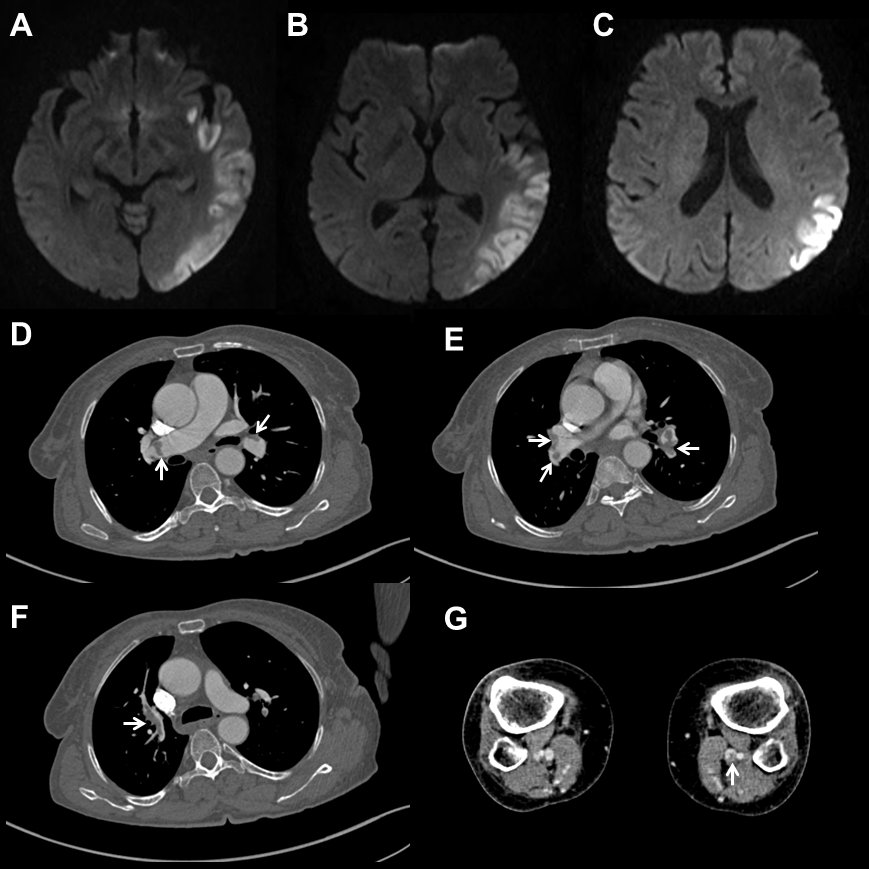Session Information
Date: Sunday, October 7, 2018
Session Title: Other
Session Time: 1:45pm-3:15pm
Location: Hall 3FG
Objective: We report a case that developed cerebral and pulmonary thromboembolism during 24-hour levodopa/carbidopa intestinal gel (LCIG) infusion.
Background: LCIG is a therapeutic option in advanced Parkinson’s disease (PD). Its use is usually limited to daytime, but extension to 24-hour can be used in cases with severe night-time disabilities.
Methods: The case was 58 year old PD patient. She developed severe motor fluctuations for the last 2 years and treated with LICG. At doses of 1800 mg levodopa, daytime motor fluctuations disappeared completely. After 3 months, we switched to 24-hour LCIG infusion with daily dose of 2300 mg, because of severely disabling nocturnal off periods. Following this alteration, her nighttime off-periods disappeared. Three months later, she was admitted to emergency unit with acute onset aphasia.
Results: Brain MRI disclosed acute ischemic lesions within left middle cerebral artery territory (Figure a-c). The blood work-up showed elevated INR (1.83), D-dimer (3.59 μg/ml) and homocysteine (248 μg/L) levels, all raised a suspicion of venous thrombosis, and led to diagnosis of acute pulmonary thromboemboli and left popliteal vein thrombosis (Figure d-g). Craniocervical CT angiography, echocardiography, 24-hour Holter monitoring and bubble studies were unyielding. Diagnosis of homocysteine-associated arterial and venous thrombosis was considered. Intravenous heparin, oral folic acid, vitamin B6, B12 and betaine were administered. In addition, 800 mg entacapone was administered to decrease L-dopa dependent homocysteine synthesis. Night-time infusion was stopped and daily levodopa dosage was decreased to 1400 mg/day. Her homocysteine level successfully decreased. She was asymptomatic at discharge, and remained symptom-free except for some unpredictable off-periods during her 1-year follow-up.
Conclusions: This case highlights that not only modest but also severe hyperhomocysteinemia may occur after 24-hour LCIG treatment. Plasma homocysteine elevation following levodopa is dose-dependent and considered to occur secondary to accumulation of S-adenosyl homocysteine as a by-product during metabolization of levodopa via the catechol-O-methyl transferase pathway. In case presented herein, addition of nighttime levodopa infusion might have elevated homocysteine level further by increasing total daily levodopa dose. Based on this experience, we recommend folic acid, vitamin B6 and B12 supplementation and homocysteine level monitoring in patients treated with high-dose LCIG.
To cite this abstract in AMA style:
E. Saka Topcuoglu, L. Mehdikhanova, E. Arsava, M. Topcuoglu, B. Elibol. Cerebral and pulmonary thromboembolism in a patient with hyperhomocystinemia treated with high dose levodopa/carbidopa intestinal gel [abstract]. Mov Disord. 2018; 33 (suppl 2). https://www.mdsabstracts.org/abstract/cerebral-and-pulmonary-thromboembolism-in-a-patient-with-hyperhomocystinemia-treated-with-high-dose-levodopa-carbidopa-intestinal-gel/. Accessed April 1, 2025.« Back to 2018 International Congress
MDS Abstracts - https://www.mdsabstracts.org/abstract/cerebral-and-pulmonary-thromboembolism-in-a-patient-with-hyperhomocystinemia-treated-with-high-dose-levodopa-carbidopa-intestinal-gel/

